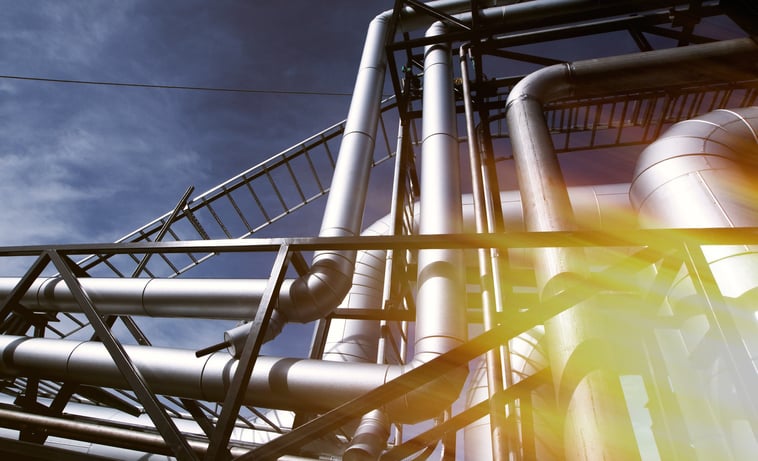
Pipes across North America are falling apart at scary rates. According to a Utah State University study, pipe breaks were up 27 percent between 2012-2018. But there is a way to stop pipe ruptures and extend the life of pipes.
Introducing the piping fountain of youth: pipe supports.
So, what’s the role of these heroes, and how can they make pipes last longer? We’ve got the answers. Here’s a guide to pipe supports and how they strengthen pipe systems.
What Is a Pipe Support?
Pipe supports are tools that stop corrosion, protect against ruptures, and extend the life of piping systems. As a whole, “pipe support” is a broad term for any equipment or product that reinforces pipes. However, under that umbrella, pipe supports include pipe restraints, isolators, and pipe shoes.
The Benefits of Pipe Supports
Piping systems are up against all kinds of turmoil. They’re highly pressurized and carry corrosive materials. Unaltered, they can swing, vibrate, rub on other metals, and cause destruction. Pipe supports are made to curb the dangers pipes face. Here’s how they can help:
- They add stabilization.
- They stop corrosion.
- They absorb vibrations.
- They elevate and organize pipes.
With those general benefits in mind, here’s how specific types of pipe supports help in different ways:
Pipe Restraints
Pipe restraints are pipe supports that control pipe movement. When used correctly, they can drastically reduce the stress that’s put on pipes and whole systems. That’s because vibrations, movement, and gradual shifts caused by thermal expansion and contraction all lead to friction. As pipes rub against other objects, they wear down, tear, and rupture.
Fittingly, pipe restraints control movement and guide pipes in the right direction. And if they have an effective liner or the right design, they can also absorb vibrations.
However, they can be a disadvantage if you use them the wrong way. Pipe restraints shouldn’t be used just to pin down pipes against a beam or structure. This leads to focused pressure and broken pipes or restraints. Instead, an effective pipe restraint will redirect movement, guide the motion of pipes, and absorb vibrations.
Common Types of Pipe Restraints
- U-bolt: U-bolts are good for basic pipe systems because they’re usually inexpensive and easy to install. However, they might not hold up in vibration-heavy environments. It’s also important to add thermoplastic coatings or protective finishes to stop metal-on-metal corrosion.
- Hold-down straps: These are the go-to pipe restraints if you need something more advanced than a U-bolt but don’t quite have a need for hold-down clamps. You can secure them to supports in a similar way to bolts, but they come with advanced liners that form around the pipe—dampening vibrations.
- Clamps: Hold-down clamps are built to take a hefty punch. They can withstand 20,000 pounds of pressure and extreme temperatures. These restraints are designed to control heavy pipes, absorb strong vibrations, and help pipes move in the right direction.
Isolators
Isolators protect pipes from harmful contact with objects around them. They do this by stopping corrosion, reducing the grind of friction, and protecting against metal-on-metal contact. Isolators act as a support layer that separates a pipe from the dangers around it.
Common Types of Isolators
- Wear pads: These supports keep pipes away from the most vulnerable corrosion points. They keep pipes from rubbing against concrete supports, guides, or beams that could cause damage.
- Flat plates: Flat plates work best on flat surfaces. They’re easy to install and resistant to corrosion, which means they can keep pipes from scraping against metal, wearing down, and corroding.
- Slide plates: Slide plates are built to hold heavy pipes and cut down friction. Because they help pipes glide, they stop the wear on piping, especially at points that are constantly expanding and contracting, including joints.
Pipe Shoes
Pipe shoes elevate pipes and prevent corrosion. By lifting the pipe off its surroundings, you protect it from metal-on-metal wear, galvanic corrosion, and corrosion that’s caused by bacteria or pooled water. Pipe shoes also eliminate the need for welding, which often can serve as a weak spot in systems.
Common Types of Pipe Shoes
- T-slide pipe shoes: T-slide pipe shoes include a pair of clamps that wrap around the pipe. They lift the pipe and keep it from rubbing against, corroding, or crashing into surrounding objects.
- CryoTek Pipe Shoes: CryoTek Pipe Shoes are nonmetallic, which means they’re built to withstand extreme temperatures. Their design makes them especially well-suited for frigid systems that use cryogenic piping. At the same time, they can take heat up to 400 degrees Fahrenheit.
- ProTek Pipe Shoes: ProTek Pipe Shoes are built to stabilize systems that flex. In fact, they can withstand 150,000 pounds of compression. They’re a good option for plants and refineries because they’re chemical-resistant and hold up in extreme temperatures.
Extending the Life of Your Piping System
Pipe supports come in all kinds of shapes and sizes. But they all can be life-cycle boosters for pipes. If you have a pipe support need for your next project, send us a note. We want to help you get the most out of your pipes.





